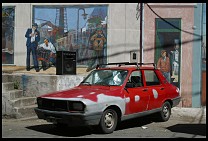
Argentina December 2003
an exhibit for friends by Philip Greenspun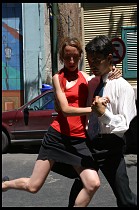

|
Argentina December 2003an exhibit for friends by Philip Greenspun |

|
Here are some graduating law students being pelted with raw eggs by friends and family. This is one tradition we might want to consider importing to the U.S.!
Compared to the great cities of the Old World, there isn't a whole lot for a tourist to see in Buenos Aires. It is a big city with a lot of shops and some nice architecture.
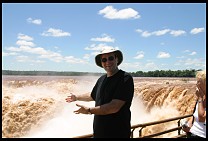
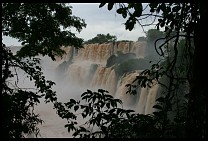
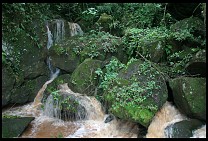
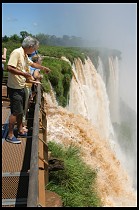
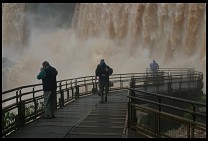
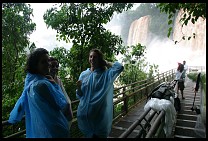
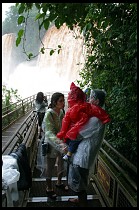
Iguazu is a rugged wilderness experience.
It is tough to get an overall perspective on the falls unless you take a helicopter tour from the Brazilian side. If you're a U.S. citizen, however, the Brazilians impose the following barriers: (a) must apply for a visa in advance by sending passport to consulate, (b) must pay $140, (c) fingerprinting and photographing at the border, which might result in delays.
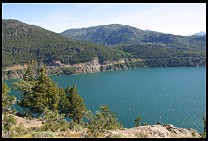
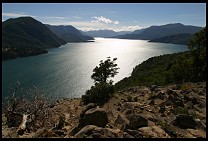
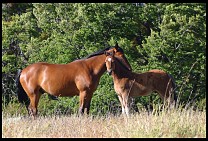
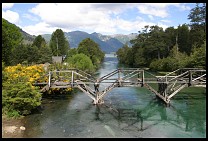
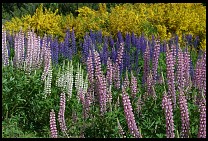
Julie and Justine, an English and South African backpacking team. They'd just walked out of the woods after four days and were hitchhiking back to civilization when I found them. If I hadn't stopped there was a bus on this dirt road that leads to a lake in Chile. The bus runs once a week.
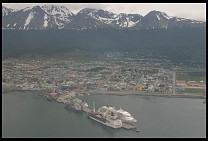
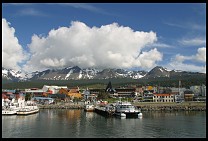
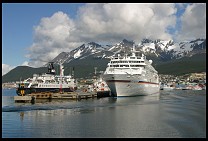
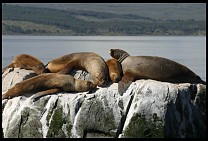
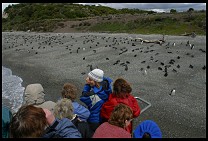
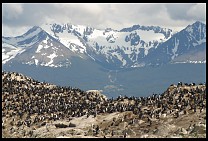
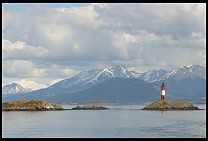
The only available Hertz rental car was a miniature affair with rather fragile tires. After every 30 miles on the gravel roads around Ushuaia the wheels would be bent and the tires would start leaking. Fortunately there are plenty of tire shops in Ushuaia and it only costs $2 to have a guy come out with a sledge hammer and pound a wheel back into some semblance of cylindricity.
Fortunately the local flying club's airplanes are a lot sturdier than the rental cars. Here's me and Claudio in a Piper Archer:
Argentina is a fabulous place for people from the northern hemisphere to enjoy a vacation from our cruel dark winter. Here are some good reasons to visit Argentina:
Days 1-3: Buenos Aires. Most of the domestic flights within Argentina leave from the downtown airport. You, on the other hand, will be arriving at Ezeiza, a 45-minute trip from the center of town. If you've already got your luggage and are in a taxi you might as well spend a few days exploring B.A. rather than attempting to catch a flight somewhere else. B.A. is a lifestyle city more than a tourist city so try to get some introductions to friends or relatives of friends.
Day 4-6: Iguazu Falls. A 1.5-hour flight to the NE brings you into subtropical jungle and the world's most powerful waterfall. The falls are best explored from the Argentine side. If you are a U.S. citizen you need to get a visa in advance and fork over $140 to visit the Brazilian side, which really isn't worth the trouble unless you're desperate to take a scenic helicopter flight (banned in Argentine airspace). If you've got the Brazilian visa it might be worth adding an extra day. Once in Brazil you have the opportunity to proceed further across the Paraguayan border and visit a big hydroelectric project upstream, sadly one that inundated a waterfall of a similar size and beauty to Iguazu.
Day 7-14: fly from Iguazu to San Martin de los Andes, in northern Patagonia (might be a little tough to arrange, at least without an overnight in B.A.). Try to find a rental car that you can drop off in Bariloche and/or take a "Seven Lakes route" tour bus at the end of your stay in San Martin. Be aware that even in the middle of summer Patagonia can be a chilly 10-20 degrees C and windy. At 41 degrees south the latitude here is comparable to Boston in the Northern Hemisphere. However, there isn't a big continental land mass to generate hot summer temps. Patagonia is like a little finger poked into the cold Southern Ocean.
Day 15-17: Calafate. Unless you've seen a lot of glaciars in Alaska or New Zealand, the sight of a thick glaciar calving icebergs into a lake should make Calafate worth the stop. You have to stop here anyway if you're flying from Bariloche to Ushuaia so you might as well get off the plane.
Day 18-20: Ushuaia. At 54 degrees south this is the southernmost city it the world (comparable to Edmonton, Alberta or Manchester, England). Go hiking in the Tierra del Fuego National Park. Take the all-day Rumbo Sur cruise that visits the sea lions, penguins, and Harberton ranch. Enjoy the snow-covered mountains behind the city. Be prepared for cold temperatures, at least a bit of rain most days, and some wind. A typical mid-summer temperature here is 12C. Warning: Ushuaia is a bit like Alaska in hospitality as well as scenery. People move here because they don't really like other people... then they get jobs in hotels and restaurants. On average the welcome you receive in Ushuaia is better than in most parts of the U.S. but the quality of services and friendliness is lower than in the rest of Argentina.
Day 21: You can get a direct flight from Ushuaia to Ezeiza (EZE). Hang out at the airport Internet cafe and write to your friends about what a fun trip you had. Then catch an overnight flight to NY (10+ hours) or Miami (8 hours). The First Class seats on the American Airlines 777s to Miami fold completely flat for sleeping.
For the next trip....